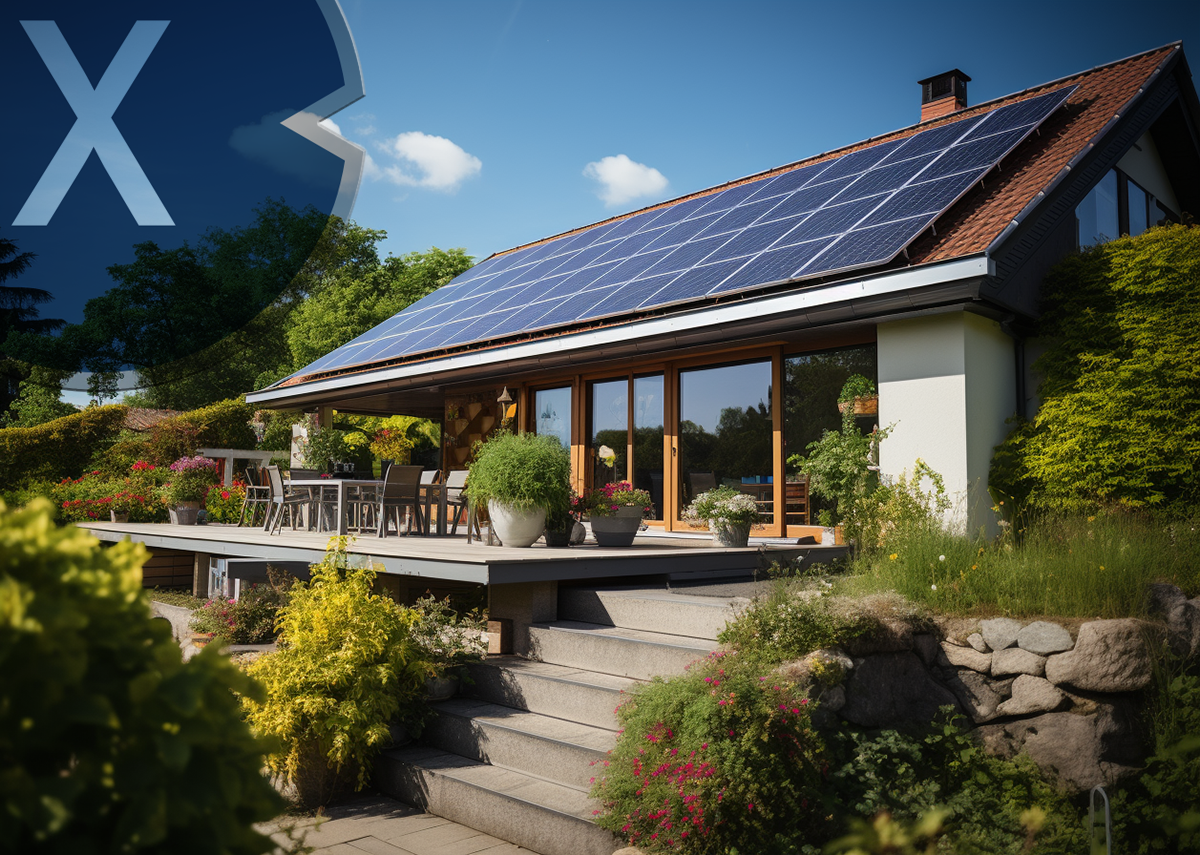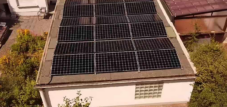
Making every roof usable: From flat to steep – Maximize solar energy on any roof type – Image: Xpert.Digital
🌱🔧 Individual solar solutions: Adapting to roof types for a more sustainable future
☀️ Solar energy on every roof: A comprehensive overview
The use of solar energy represents a crucial step towards a more sustainable and environmentally friendly future. Its integration into urban and rural areas through the installation of solar panels on various roof types marks an innovative approach to addressing the challenges of climate change. This process requires a deep understanding of the diverse roof architectures, the specific challenges of each roof shape, and the technological solutions for maximizing the efficiency of solar energy use.
🏠 The basic role of roof types
The suitability of a roof for installing a solar power system depends on several factors closely linked to its architectural features. One of the first criteria to consider when selecting a suitable solar solution is the roof shape. Flat roofs, pitched roofs, sloping roofs, and steep roofs each present unique challenges and opportunities for solar panel installation.
📐 Flat roofs: Ideal platforms with flexible possibilities
Flat roofs are characterized by their easy accessibility and the freedom to optimally align solar panels with the sun's position. This roof shape makes it possible to maximize energy yield through precise panel alignment without the natural limitations of pitched roofs. The challenge lies in avoiding potential shadows cast by neighboring structures to ensure energy efficiency is not compromised.
🏡 Pitched roofs: The balance between aesthetics and functionality
Pitched roofs are predominant in residential areas, presenting both challenges regarding orientation and tilt, and opportunities for the aesthetic integration of solar panels. Optimal tilt and orientation to the sun can significantly influence energy production, while innovative installation methods allow the panels to be harmoniously integrated into the overall appearance of the house.
🌨 Pitched roofs: Potential despite the forces of nature
Pitched roofs, frequently found in areas with heavy snowfall or rainfall, offer effective water and snow drainage due to their design. For the installation of solar panels, this means additional considerations regarding the roof's load-bearing capacity. While the natural slope often provides an excellent southern exposure, the structural properties must be carefully examined to achieve maximum performance.
⛰ Pitched roofs: Where tradition meets innovation
Steep roofs, recognizable by their pronounced slope, present an interesting challenge for solar panel installations. Their structure facilitates snow slideoff, allowing for quick re-expansion of the solar panels. However, their steep angle and height necessitate increased safety precautions during installation. Modern mounting systems can ensure optimized orientation, thereby maximizing the efficiency of the solar modules even on these roofs.
🤔 Further crucial considerations
Besides the roof's design, local weather conditions, potential shading from surrounding natural features or buildings, and economic and political frameworks play a crucial role in planning a solar power system. Funding opportunities, electricity price trends, and the payback period are key aspects influencing the attractiveness and feasibility of solar energy projects.
🌍 The path to a sustainable future
Through careful planning and adaptation to specific conditions, almost any roof can be transformed into a source of sustainable energy. The fusion of traditional architecture and advanced solar technology makes it possible to actively contribute to climate protection and meet energy needs in an environmentally friendly way. In this sense, the use of solar energy on roofs of various building types is not only an answer to the energy challenges of our time, but also a sign of the innovative spirit that is paving the way to a greener future.
📣 Similar topics
- 🌞 The solar energy revolution: On the way to greener cities and villages
- 🏠 Architectural challenges: Solar energy and the diversity of roof types
- 🏗 Optimizing flat roofs for solar energy: A detailed analysis
- 🌲 Aesthetics meets functionality: Solar panels on pitched roofs
- ❄️ The power of pitched roofs: Natural forces and solar energy working hand in hand
- 🏔 Traditional pitched roofs in the age of solar technology
- 📊 Economic and political factors influencing solar energy projects
- 💡 Innovative mounting systems for solar panels: A secure future
- 🌨 Climatic challenges for solar power systems: Of sunshine and shadows
- 🌱 The Green Path: How Solar Energy is Shaping the Future of Our Energy Supply
#️⃣ Hashtags: #SolarEnergy #SustainableFuture #RoofTypes #EnergyEfficiency #InnovativeSolarTechnology
Plan your solar system for the most common applications conveniently online with our solar system planner!
With our user-friendly solar system planner you can plan your individual solar system online. Whether you need a solar system for your home, your business or for agricultural purposes, our planner offers you the opportunity to take your specific requirements into account and develop a tailor-made solution.
The planning process is simple and intuitive. You simply enter relevant information. Our planner takes this information into account and creates a tailor-made solar system that meets your needs. You can try out different options and configurations to find the optimal solar system for your application.
Additionally, you can save your plan to review later or share with others. Our customer service team is also available to answer your questions and provide support to ensure your solar system is optimally planned.
Use our solar system planner to plan your individual solar system for the most common applications and advance the transition to clean energy. Start now and take an important step towards sustainability and energy independence!
The solar system planner for the most common applications: Plan the solar system online here - Image: Xpert.Digital
More about it here:
🌞 Solar energy on every roof: Adaptable to various roof types
🌱 The importance of solar energy
Solar energy is a virtually inexhaustible, clean energy source generated by converting sunlight into electricity using solar cells. As part of global efforts to reduce CO2 emissions and combat climate change, solar energy plays a vital role. It not only reduces dependence on fossil fuels but also promotes energy independence for countries and individuals.
🏠 Adaptable to various roof types
One of the challenges in the widespread application of solar technology lies in the adaptability of the systems to different roof types. Roofs vary considerably in shape, size, and material, requiring individual planning and installation of solar panels. Whether flat roof, pitched roof, shed roof, or green roof – every roof has specific characteristics that must be considered when installing solar modules.
⬜ Flat roofs
Flat roofs offer the opportunity to optimally align solar panels with the sun, as they allow for a high degree of flexibility in module arrangement. An important aspect here is structural stability: solar systems on flat roofs must be designed and installed in such a way that they neither overload the structure nor cause damage to the roof membrane.
🏡 Gable roofs
Gable roofs are the most common roof type in many regions. Installing solar panels on gable roofs is often easier and less expensive than on other roof types, as the roof pitch already provides a natural orientation towards the sun. However, it is important to consider the roof's orientation and pitch to maximize the solar panel's energy yield.
📐 Pitched roofs
Pitched roofs with a single slope require careful planning to effectively utilize solar radiation. The roof's orientation to the sun is crucial for the efficiency of the solar system.
🌿 Green roofs
Green roofs, or roofs covered in vegetation, present a particular challenge. The combination of green roofs and solar technology is trending and unites ecological and economic advantages. The installation of solar modules on green roofs must be carefully planned to avoid damaging the vegetation while still ensuring efficient electricity generation.
🔧 Installation and maintenance
Installing a solar power system requires expert knowledge, especially when it comes to integrating it into existing roof structures. Professional installation not only ensures maximum system efficiency but also minimizes the risk of damage to the roof and the solar panels themselves. After installation, regular maintenance of the solar panels and related systems is essential to guarantee their longevity and efficiency.
💰 Economic and ecological aspects
Investing in solar technology offers both economic and environmental benefits. Economically, this includes long-term savings on electricity costs, as well as potential government subsidies and tax breaks. Environmentally, every installed solar system contributes to reducing CO2 emissions and promotes the sustainable use of our resources.
⚙️ Future-oriented trends
Innovative technologies such as the integration of photovoltaic elements into building materials or the development of solar cells with higher efficiencies promise an even closer link between architecture and solar technology. Furthermore, storage solutions for solar power are increasingly coming into focus in order to enable an independent and continuous energy supply.
🌟 Using solar energy through solar panels on every roof
The use of solar energy through solar panels on every roof is a key component of a sustainable energy future. Technological advancements allow for increasingly better adaptation to various roof types, thus maximizing the efficiency of energy harvesting from sunlight. By combining economic and environmental benefits, solar energy offers a unique opportunity to actively participate in climate protection while simultaneously promoting energy independence. Ongoing innovation in this field promises to further simplify and improve the integration and use of solar energy. This ensures that the sun remains one of the most promising sources of clean, renewable energy for present and future generations.
📣 Similar topics
- 🌞 Solar energy: A key to the global energy transition
- 🏡 Roof types and their importance for solar energy efficiency
- 📐 Adapting solar panels to different roof structures
- 🌱 Green roofs: The combination of ecology and solar technology
- 🔧 Professional installation and maintenance of solar systems
- 💡 The role of solar energy in the fight against climate change
- 💸 Economic and ecological advantages of solar power systems
- 🔋 Future-oriented storage solutions for solar energy
- 🌿 The integration of photovoltaic elements into building materials
- ⚡ Ongoing innovation in solar technology
#️⃣ Hashtags: #SolarEnergy #RenewableEnergy #RoofTypes #Sustainability #EnergyIndependence
We are there for you - advice - planning - implementation - project management
☑️ Expert advice on energy-efficient renovation and new construction
☑️ with solar solutions and heat pumps/air conditioning systems
I would be happy to serve as your personal advisor.
You can contact me by filling out the contact form below or simply call me on +49 157 30 44 9 555 .
I'm looking forward to our joint project.
Xpert.Digital - Konrad Wolfenstein
Xpert.Digital is a hub for industry with a focus on digitalization, mechanical engineering, logistics/intralogistics and photovoltaics.
With our 360° business development solution, we support well-known companies from new business to after sales.
Market intelligence, smarketing, marketing automation, content development, PR, mail campaigns, personalized social media and lead nurturing are part of our digital tools.
You can find out more at: www.xpert.digital - www.xpert.solar - www.xpert.plus

